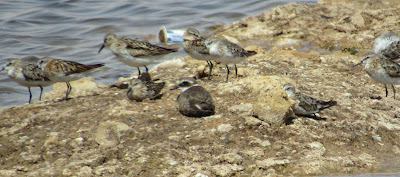The authorities had started pumping it out. The level had reduced and I had assumed it would all be gone as part of the drive to remove standing water throughout the city.
Whether the heavy rain last week (when 40% of a year's rain fell in one day) has topped the water up or the authorities have decided to allow the lake to remain at the new lower level, I still don't know. I can see that the three low lying houses have already repainted their walls suggesting they believe levels will never rise again.
Either way, I enjoyed the birding while I could.
squacco heron
Large birds are generally the most easily seen and there was some variety of heron family members. Three squacco heron may not sound many but it is the largest number I have observed at this site.
little egret
There are often a reef heron or two on site but rarely do I see its close cousin, little egret.
glossy ibis
coot chicks
It is not the only place in sub-Saharan Africa where they have bred. I am told that they have bred in Northern Senegal though I don't know the scale or regularity. I wonder if sub-Saharan breeding is actually wider spread. It would be interesting to know whether any of the pools off the Niger river in Mali support them too. It is a known wintering ground and I would imagine the conditions are similar.
several coot
There is a high probability that the coot seen at this time of year where born here.
little grebe (left)
African swamphen
None have left yet. African swamphen can still be seen in or close to the reeds.
garganey (left) and moorhen (right)
Moorhen are still present in seemingly their usual numbers too. The one above was swimming next to a garganey. Indeed the garganey was not the only duck on site.
northern pintail
marbled duck
One duck that is definitely new was a marbled duck. The lake had up to six in the early winter last year so this species wasn't a surprise though the timing was. There again no two years are the same.
mostly little stint
common ringed plover
Several common ringed plover and the odd common sandpiper added to the mix.
common greenshank (left)
Common greenshank and ruff are not observed so commonly at the lake. This is particularly true of ruff.
ruff
southern grey shrike
black tern
black-headed gull 1
black-headed gull 2
first year willow warbler
sedge warbler
I got prolonged views of two sedge warbler albeit from distance and in two quite different parts of the lake. Last winter I saw one or two all winter long. I study them all for aquatic warbler but I have always drawn a blank. I think I deserve one for the effort especially as thier main wintering ground worldwide is only 200 kilometres way on the Senegal River delta.
In birding, everything comes in the end if you are patient and persistent enough.
Species seen at F-Nord lake on September 2nd
Garganey
Northern Pintail
Marbled Duck
Little Grebe
Grey Heron
Little Egret
Squacco Heron
Glossy Ibis
African Swamphen
Common Moorhen
Eurasian Coot
Spur-winged Lapwing
Common Ringed Plover
Ruff
Little Stint
Common Sandpiper
Common Greenshank
Wood Sandpiper
Black-headed Gull
Black Tern
Speckled Pigeon
Laughing Dove
Little Swift
Blue-cheeked Bee-eater
Southern Grey Shrike
Woodchat Shrike
Willow Warbler
Western Olivaceous Warbler
Sedge Warbler
Eurasian Reed Warbler
Western Yellow Wagtail
House Sparrow





















No comments:
Post a Comment